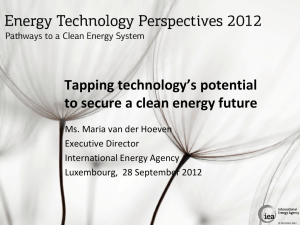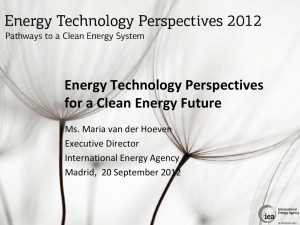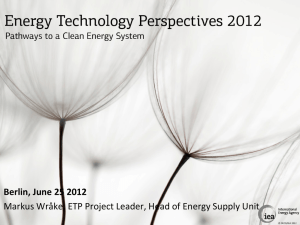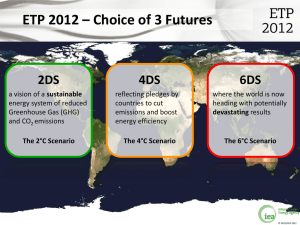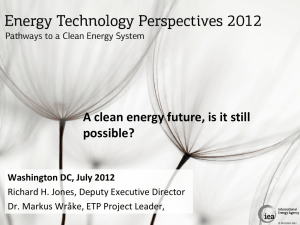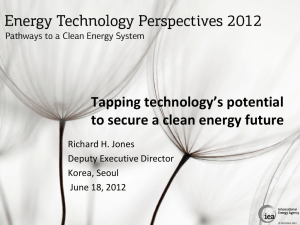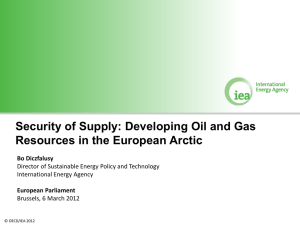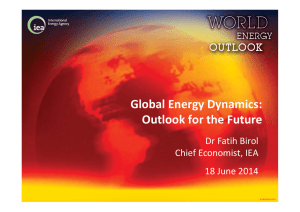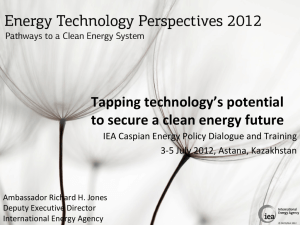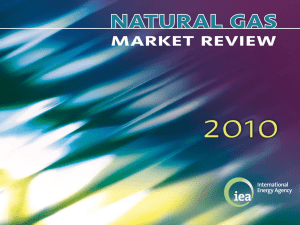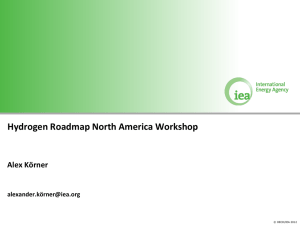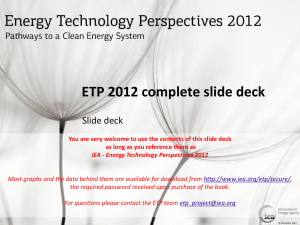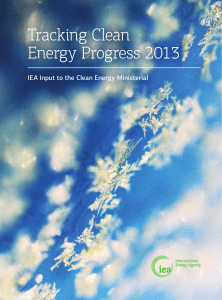PPT
advertisement
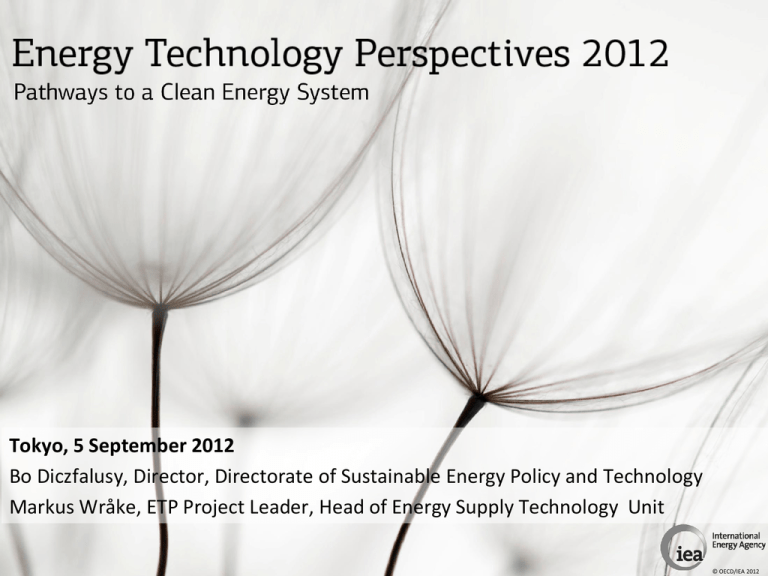
Tokyo, 5 September 2012 Bo Diczfalusy, Director, Directorate of Sustainable Energy Policy and Technology Markus Wråke, ETP Project Leader, Head of Energy Supply Technology Unit © OECD/IEA 2012 ETP 2012 – Choice of 3 Futures 2DS a vision of a sustainable energy system of reduced Greenhouse Gas (GHG) and CO2 emissions The 2°C Scenario 4DS reflecting pledges by countries to cut emissions and boost energy efficiency The 4°C Scenario 6DS where the world is now heading with potentially devastating results The 6°C Scenario © OECD/IEA 2012 Clean energy: slow lane to fast track Cleaner coal power Nuclear power Renewable power CCS in power CCS in industry Industry Buildings Progress is too slow in almost all technology areas Significant action is required to get back on track Fuel economy Electric vehicles Biofuels for transport © OECD/IEA 2012 Renewables provide good news Renewable power generation 42% 75% 27% Average annual growth in Solar PV Cost reductions in Solar PV in just three years in some countries Average annual growth in wind Energy RD&D has slipped in priority 12% 25 6% 10 4% 5 4 3 2 2% 1 1990 1994 1998 2002 2006 2010 Energy efficiency Fossil fuels Renewable energy Nuclear Hydrogen and fuel cells Other power and storage technologies Other cross cutting technologies/research Share of energy RD&D in total R&D South Africa 1986 Russia 1982 Mexico 1978 India 1974 China 0 0% 0 Brazil USD billion 15 2008 non-IEA country spending USD billion 8% Share of energy RD&D in total R&D 10% 20 © OECD/IEA 2012 A smart, sustainable energy system Co-generation Renewable energy resources Centralised fuel production, power and storage Distributed energy resources Smart energy system control H2 vehicle Surplus heat EV A sustainable energy system is a smarter, more unified and integrated energy system © OECD/IEA 2012 Recommendations to Governments 1. Create an investment climate of confidence in clean energy 2. Unlock the incredible potential of energy efficiency – “the hidden” fuel of the future 3. Accelerate innovation and public research, development and demonstration (RD&D) © OECD/IEA 2012 Low-carbon electricity: a clean core Global electricity generation in the 2DS 45 000 Other Wind Solar Hydro Nuclear Biomass and waste Oil Gas with CCS Gas Coal with CCS Coal 40 000 TWh 35 000 30 000 25 000 20 000 15 000 10 000 5 000 0 2009 2020 2030 2040 2050 Renewables will generate more than half the world’s electricity in 2050 in the 2DS © OECD/IEA 2012 Renewables grow in Japan but uncertainty is high TWh Drivers: Uncertainties about nuclear restart New feed-in tariffs Good match of solar PV for shaving peak load Challenges: Power system fragmentation Relatively high capital costs of renewable energy Location of wind and geothermal resources far from demand centres Japan forecast renewable generation 180 160 140 120 100 80 60 40 20 0 2011 2012 2013 2014 2015 2016 2017 Hydropower Bioenergy Solar PV Wind onshore Geothermal Wind offshore Japan power generation by share, 2011 100% 90% 80% 70% 60% 50% 40% 30% 20% 10% 0% IEA MRMR report 2010 Jan 11 Nuclear Mar 11 May 11 Combustible Fuels Jul 11 Sep 11 Hydro Nov 11 Other © OECD/IEA 2012 Power generation; Nuclear Installed capacity Nuclear deployment by 2025 will be below levels required to achieve the 2DS objectives after the Fukushima accident although the vast majority of countries remain committed to its use. © © OECD/IEA OECD/IEA 2012 2012 Natural gas as a transitional fuel Power generation from natural gas increases to 2030 in the 2DS and the 4DS. From 2030 to 2050, generation differs markedly. 10 000 TWh 4DS 10 000 7 500 7 500 5 000 5 000 2 500 2 500 0 2009 2020 2030 2040 OECD 2050 2DS 0 2009 2020 2030 Non-OECD 2040 2050 Natural gas-fired power generation must decrease after 2030 to meet the CO2 emissions projected in the 2DS scenario. © OECD/IEA 2012 The CCS infant must grow quickly Mt CO2 Mt CO2 Mt CO2 Mt CO2 Mt CO2 Mt CO2 Note: Capture rates in MtCO2 /year © OECD/IEA 2012 Heating & Cooling: the forgotten giant Renewable heat Integration with electricity District heating and cooling network Co-generation Surplus heat Heating and cooling account for 46% of global energy use. Their huge potential for cutting CO2 emissions is often neglected. © OECD/IEA 2012 End-use energy efficiency is critical In the Japanese buildings sector, reduced electricity demand and power decarbonisation are key to achieve the 2DS. Global Passenger LDV sales (million) Electric vehicles need to come of age 200 FCEV Fuel Cell Electric Vehicles Electricity 150 Plug-in hybrid diesel Plug-in hybrid gasoline Diesel hybrid 100 Gasoline hybrid CNG/LPG 50 Diesel 0 2000 Gasoline 2010 2020 2030 2040 2050 More than 90% of new light duty vehicles need to be propelled by an electric motor in 2050 © OECD/IEA 2012 Fuel economy makes a difference PLDV tested fuel economy - Japan (new car average, JC08eq.) PLDV fuel consumption - 8 50 Japan Target 6 6DS 4 Better FE 2 2DS(I/A/S) 0 2010 2020 2030 2040 2050 [Billion Lge/year] [Lge/100km] 10 Japan 40 6DS 30 Better FE 20 2DS(I/A/S) 10 0 2010 2020 2030 2040 2050 Fuel economy improvements in conventional and hybrid vehicles alone can reduce fuel consumption by one third in 2050. © OECD/IEA 2012 Alternative fuels are essential 90 % of sales in Japan in 2050 should be an electrically driven car with low carbon electricity and hydrogen © OECD/IEA 2012 Translating targets into action 8 million sales/year 7 Manufacturers production/sales 6 5 Projection (Estimated from each country's target) Projection (Estimated from each country's target) 4 3 2 1 0 2010 2012 2014 2016 2018 2018 2020 2020 Government targets need to be backed by policy action © OECD/IEA 2012 Clean energy investment pays off Additional investment Additional investment Power Industry Transport Fuel savings Residential Total savings Commercial Undiscounted Fuel savings Biomass Coal 10% Oil - 120 - 80 - 40 0 40 USD trillion Gas Every additional dollar invested in clean energy can generate 3 dollars in return. © OECD/IEA 2012 Sustainable future still in reach Is a clean energy transition urgent? Are we on track to reach a clean energy future? Can we get on track? YES ✓ NO ✗ YES ✓ © OECD/IEA 2012 For much more, please visit www.iea.org/etp © OECD/IEA 2012
